Raccoons are renowned for their adaptability, thriving in a remarkably diverse range of environments. From the tranquility of dense forests to the bustling activity of urban centers, raccoons demonstrate an impressive ability to make themselves at home wherever food and shelter are available. You might find them foraging for sustenance in lush woodlands near water or cleverly navigating the challenges of human-dominated landscapes. If their natural habitats face disruption due to deforestation or human encroachment, raccoons readily adapt, often moving into suburban and urban communities. This article delves into the fascinating world of raccoon habitats, exploring the various places these resourceful animals call home.
Natural Habitats of Raccoons
While raccoons are often associated with forests, their habitat preferences are quite flexible. They favor areas with dense vegetation that offers ample shelter, but their primary needs are simple: food, water, and safety. Across North America, a wide array of habitats readily meet these requirements. In their natural settings, raccoons commonly inhabit hollow trees situated near rivers, streams, and other water bodies. These riparian zones provide both essential resources and protection. However, their adaptability shines through as they also flourish in urban and suburban environments, including parks, agricultural lands, and even residential backyards.
A raccoon’s ideal natural habitat is typically characterized by forested regions close to water sources like rivers or streams, which are crucial for finding food and maintaining hydration. These resourceful creatures thrive in various wild settings, such as marshlands, wetland forests, and wooded areas, often traveling in groups to efficiently locate food and secure shelter. For den sites, they exhibit versatility, utilizing self-dug dens, abandoned burrows created by other animals, the cavities of mature trees, dense piles of brush, riverbanks, rocky ledges, thickets, and rock crevices. These diverse denning options provide protection from predators and offer refuge from inclement weather.
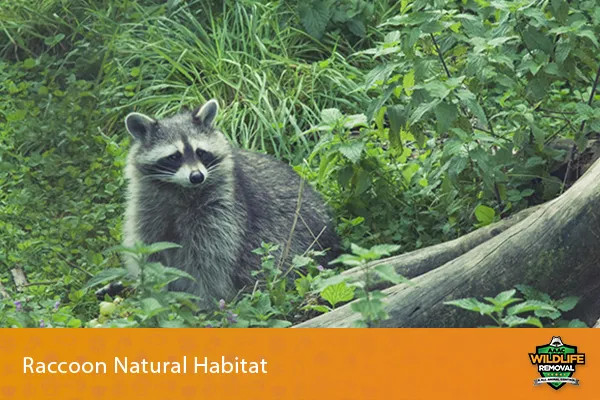 A raccoon nestled in its natural woodland habitat
A raccoon nestled in its natural woodland habitat
Raccoons Across North America: Habitat Diversity
Raccoons boast a wide distribution throughout North America, encompassing Canada, the United States, and Mexico. Their adaptability is further highlighted by the variety of habitats they occupy across this vast continent. These include woodlands, savannas, prairies, and even swamps, each offering different resources and challenges. Access to water sources is a common thread, as raccoons require water for drinking and foraging. Interestingly, raccoons are also highly successful in urbanized areas, readily adapting to city life and frequently encountering humans. These varied living conditions can significantly impact a raccoon’s life, influencing factors such as their diet and ultimately, their lifespan.
Urban Raccoons: Adapting to City Life
As urbanization expands, the interface between humans and wildlife intensifies. Raccoons, with their remarkable adaptability, frequently establish homes in close proximity to human residences. This is particularly true when easily accessible food sources are present, such as unsecured trash cans, bird feeders, bird eggs, backyard ponds, and pet food left outdoors.
Raccoons inhabiting suburban and urban areas often seek shelter in man-made structures. Attics, spaces under decks and porches, and sheds become convenient den sites. While they are adept at coexisting with humans, their presence can sometimes lead to nuisance issues. Rummaging through trash cans, causing property damage, and becoming involved in vehicle collisions are common challenges associated with urban raccoon populations.
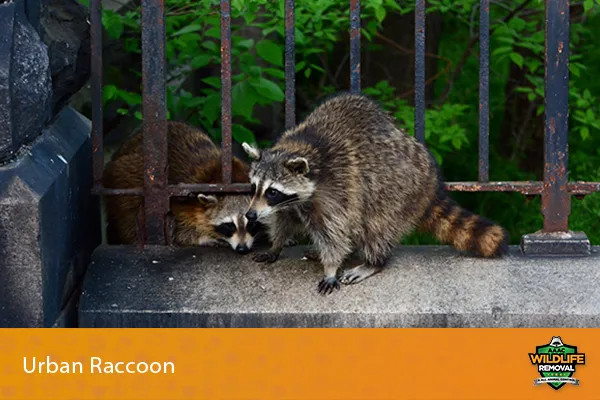 Raccoons skillfully navigating an urban environment
Raccoons skillfully navigating an urban environment
Raccoon Dens: Home Sweet Home
A raccoon den is essentially a nest, constructed from readily available materials. Leaves, twigs, and dry grass are commonly woven together to create a comfortable and insulated space. During the colder winter months, raccoons often seek refuge in attics for the added warmth and protection. In situations where natural denning materials are scarce within a human dwelling, raccoons may even utilize insulation to create a suitable den.
Denning Habits: Differences Between Female and Male Raccoons
During the mating season, female raccoons exhibit a preference for den sites located high off the ground, often choosing tree cavities. This elevated location may offer enhanced protection for potential offspring. However, when females are actively raising their young (juveniles) or during their gestation period, they tend to select den sites closer to the ground. Hollow logs or burrows previously excavated by other animals become more appealing options during this phase.
Adult male raccoons, in contrast, typically maintain a network of multiple dens and frequently rotate between them. A male raccoon might switch dens daily or every few days, a behavior that differs from females who generally remain in a single den for extended periods, particularly when raising young.
In What Kind of Places Do Raccoons Dwell?
Raccoon dwellings are diverse and depend significantly on whether they are situated in suburban and urban settings or in wild, natural environments. In urban areas, raccoons frequently reside in attics or beneath decks, capitalizing on the easy access to food resources and the shelter these locations provide from adverse weather conditions. Raccoons in the wild favor natural dens found within hollow logs, brush piles, or abandoned burrows created by other animals, blending seamlessly into their natural surroundings.
Winter Havens: Where Do Raccoons Go When It’s Cold?
As winter approaches, many people wonder about the winter habits of raccoons. Unlike some animals that migrate to warmer climates, raccoons typically remain in their existing territories. Instead of migrating, they seek shelter in their dens and enter a state of deep sleep called torpor. This period of reduced activity and metabolism helps them conserve energy during times of food scarcity and cold temperatures.
Sewers and Raccoons: Myth vs. Reality
The occasional sighting of raccoons near sewers and storm drains can lead to the question: “Do raccoons live in sewers?” While raccoons are sometimes observed in these underground systems, sewers are not their primary residences. Instead, raccoons primarily utilize sewers and storm drains as passageways to navigate from one location to another, and sometimes as temporary foraging areas. They are known to scavenge for food in sewers when other options are limited, but they do not typically establish permanent dens within these environments.
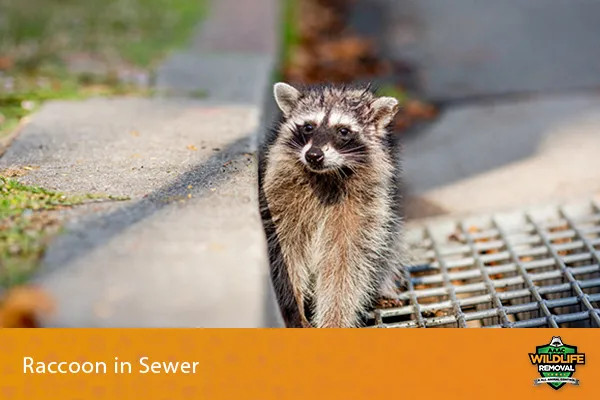 A raccoon exploring a sewer environment
A raccoon exploring a sewer environment
Tree Dwellers? Raccoons and Trees
While raccoons are adept climbers and frequently utilize tree hollows and cavities for denning, it’s inaccurate to describe them as primarily living in treetops. Raccoons generally prefer ground-level dens, such as holes and burrows. However, in urban settings, their climbing skills become particularly useful. They readily climb trees to access roofs and attics, effectively using tree branches as bridges to reach elevated entry points into human dwellings.
Nocturnal Habitats: Where Raccoons Are at Night
Raccoons are nocturnal animals, meaning they are most active during nighttime hours. Their nighttime activity is primarily centered around foraging for food and searching for water. It’s during these nocturnal excursions that homeowners are most likely to encounter raccoons in their backyards, whether they are investigating trash cans for scraps or exploring dumpsters for edible items.
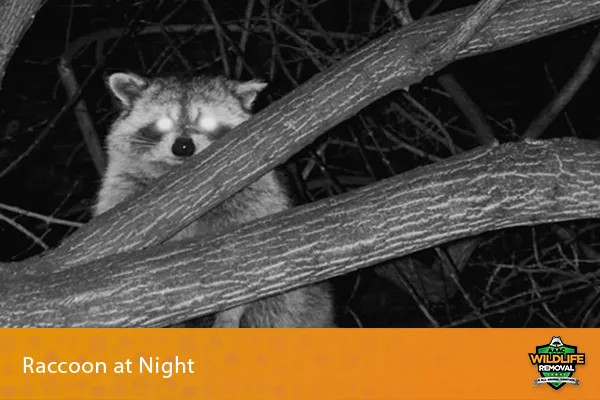 A raccoon active during nighttime
A raccoon active during nighttime
Daytime Retreats: Where Raccoons Sleep
During daylight hours, raccoons typically retreat to their dens for sleep and rest. They often maintain multiple den sites and may move between them even during the daytime. Contrary to some misconceptions, a raccoon seen moving during the day is not necessarily rabid. In many cases, daytime activity is simply due to a raccoon searching for food or relocating because its den has been disturbed or destroyed.
In natural environments, daytime dens may be located in tree cavities or hollows, or in repurposed burrows originally created by other animals. In suburban and urban areas, raccoons may utilize a variety of sheltered locations for daytime dens, including abandoned vehicles, derelict buildings, attics, spaces beneath decks and porches, and crawl spaces.
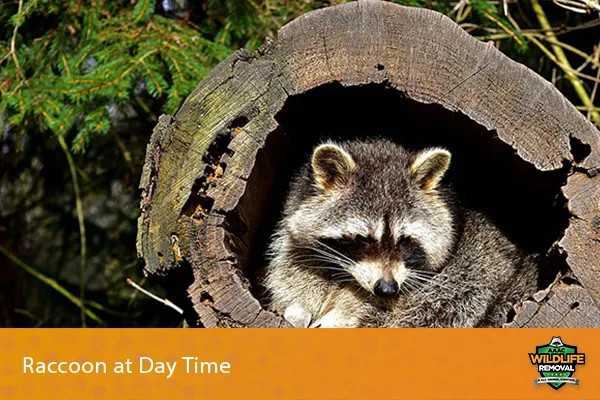 A raccoon resting during the daytime
A raccoon resting during the daytime
Why Raccoons Venture into Homes
Raccoons are drawn to homes primarily in their persistent search for food, water, and secure shelter. Their remarkable adaptability to human-modified landscapes often leads them to view homes as potential habitats. They can become remarkably unafraid of humans and will readily enter homes if opportunities arise. Pet doors offer easy access, and any existing holes or openings around a house can be exploited. Raccoons are adept at squeezing through surprisingly small gaps, creating their dens or nests within attics, under decks, or porch areas.
Raccoon Removal from Homes: A Task for Professionals
Removing raccoons once they have established themselves within a home can be a challenging and potentially hazardous undertaking. Raccoons are equipped with sharp claws and teeth, and they can inflict serious injuries if they feel threatened or cornered. Furthermore, they are known carriers of diseases and parasites, including the rabies virus, which pose health risks to humans and pets.
If raccoons invade a home, the safest and most effective course of action is to contact professional pest control or wildlife removal technicians. These specialists possess the experience and equipment necessary to safely and humanely remove raccoons from attics, crawl spaces, or other entry points. They employ humane removal methods to prevent harm to the animals during the eviction process. Homeowners should avoid attempting to handle raccoons themselves due to the inherent risks associated with these wild animals. Seeking expert assistance is crucial for safely resolving raccoon infestations.
Preventing raccoons from entering homes in the first place is always preferable. Utilizing wildlife deterrents and eliminating attractants are key preventative measures. Securing trash cans, removing pet food bowls left outdoors, and using motion-sensor lights and sprinklers can make a property less appealing to raccoons.
Seeking Expert Raccoon Removal Services
If you are experiencing issues with raccoons on your property, such as persistent rummaging through trash cans or potential home entry, contacting a professional animal removal company is recommended. Companies like AAAC Wildlife Removal specialize in the humane and safe removal of raccoons and other wildlife. Trained technicians have the expertise to identify raccoon entry points, implement effective removal strategies, and establish prevention plans to deter future wildlife intrusions. Professional intervention ensures both the humane treatment of the animals and the long-term protection of your property.
In Summary: Raccoon Habitats and Adaptability
Raccoons are highly successful urban animals due to their exceptional adaptability to human habitats and their diminished fear of humans over time. Their habitat range is extensive, encompassing deserts, forests, and urban areas. Raccoons thrive in urban neighborhoods and cities where they can readily access food sources like unsecured garbage and pet food left outdoors.
While their days are typically spent sleeping in dens, raccoons become active foragers at night, venturing out in search of food and water. Their climbing prowess and adaptability enable them to utilize a wide array of spaces as homes, including attics, crawl spaces, and areas beneath decks or porches. Due to the potential dangers associated with handling raccoons, including the risk of bites, scratches, and disease transmission, professional wildlife removal services are the recommended approach for safely and humanely resolving raccoon-related issues on your property.


